Founded in 1985 in Jacksonville, Florida, Pace Center for Girls (Pace) serves more than 3,000 at-risk girls (ages 11 to 18) annually in 23 communities in Florida and Georgia. Girls served by Pace are likely to have experienced risk factors associated with delinquency and adverse childhood experiences (ACEs). Pace applies a set of gender-responsive, trauma-informed, and strength-based prevention and early intervention practices to enhance academic and social services, thus focusing on the intersection of socio-emotional health and education. These practices contribute to improvements in girls’ self-efficacy and advocacy skills as well as their relationships with peers, family members, and adults in their communities.
This case study illustrates how Pace has adopted a Measurement-Evaluation-Learning (MEL) framework to support continuous quality improvements and produce equitable evidence. Pace blends utilization-focused and participatory evaluation with quality improvement methods to build actionable evidence. Key practices include:
- Involving critical stakeholders in research and evaluation to ask the right questions
- Using participatory mixed methods to foster evidence-based decision making
- Adopting a systemic approach to understand organizational performance and culture
- Including different perspectives in analysis to facilitate actionable findings
- Establishing strategies supporting stakeholder participation and use of information
Over the last several years, this approach has allowed Pace Center for Girls to shift from monitoring and compliance to understanding how the program has contributed to outcomes. The case study highlights the core practices of the MEL framework with examples. Challenges implementing the framework are also discussed.
The inclusion of program participants in MEL has positively affected organizational culture and social changes in the communities served. Program implementation results support the MEL framework; Pace has experienced measurable improvements in outcomes and in its agility to respond to participants’ needs.

